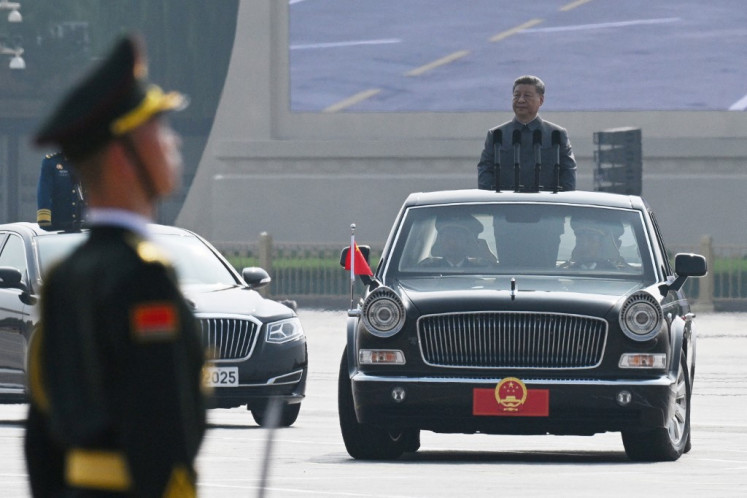Popular Reads
Top Results
Can't find what you're looking for?
View all search resultsPopular Reads
Top Results
Can't find what you're looking for?
View all search resultsTramways in Jakarta: An impossible plan?
The idea to reintroduce tramways came after a projection that the current BRT system in Greater Jakarta Area will collapse if 80 percent of the population switch to public transport by 2029. Are trams really worth it? More importantly, is it feasible to resume tram operations?
Change text size
Gift Premium Articles
to Anyone
O
n Oct. 20, 2018, the Greater Jakarta Transportation Agency (BPTJ) announced a plan to substitute Transjakarta buses (BRT) with trams to anticipate an increase in the number of public transportation passengers. The plan has been regulated in the 2019-2029 Greater Jakarta Transportation System Blueprint (RITJ), which was legalized in Presidential Decree No. 55/2018.
Everyone knows how notorious and frustrating Jakarta’s traffic is. With most business districts located downtown, commuters flock everyday into the city from surrounding suburbs in Bogor, Depok, Tangerang and Bekasi. Statistics Indonesia’s (BPS) survey in 2014 showed there were 3.4 million daily commuters. Among them, 1.4 million traveled from Greater Jakarta. Moreover, 2.4 million commuters were traveling inside the city center during the day.
In 2017, INRIX Global Traffic Scorecard ranked Jakarta having the world’s 12th worst traffic, and in 2018, Indonesia made top of the list among other countries with 209.8 vehicles per kilometer, based on a survey in several major cities including Jakarta. The saying that goes “trapped in Jakarta’s traffic enigma” is not a joke.
Transjakarta was first introduced by then-Jakarta governor Sutiyoso in 2004. Latest data shows it serves some 600,000 passengers daily along 13 corridors and several feeder routes. Indeed, Transjakarta has become a breakthrough in Jakarta’s urban transportation development.
The idea to reintroduce tramways came after a projection that the current BRT system in Greater Jakarta Area will collapse if 80 percent of the population switch to public transport by 2029.
Based on the existing Presidential Decree, the tramway will be a different public transport system than the light rapid transit (LRT), BRT or mass rapid transit (MRT). The government wanted trams to become the interchanging transport mode in heavily populated suburbs, rather than completely substituting the BRT. Concurrently, the special routes indicate tramways will serve areas that have not been reached by BRT or LRT.
Are trams really worth it? More importantly, is it feasible to resume tram operations?
Trams were once the main public transport during the end of the colonial era and in the post- independence period in major cities. In Jakarta and the second largest city, Surabaya in East Java the tram was preferred compared to other transport options because it was cost effective. Trams could reach longer distances and carry more passengers with lower energy consumption. Tram services, however, were stopped during the 1950s because it lost to more flexible transports such as cars and buses, while corruption and increasing growing lobbying from bus and automobile industries were also said to speed up tram’s termination.
We should learn from other cities or countries that have adopted trams.
A 2010 survey of the tramway system by the United States’ Federal Transit Administration offered little evidence of concrete cause and effect about the tram’s revival in southwestern cities such as Tucson and San Antonio. In these cities, reviving trams was mainly because they were part of a larger, heavily subsidized development plan, with changes in zoning, improvements to streets and other benefits.
The survey also found that the tramways redevelopment came with huge upfront costs in laying down rails and buying cars. According to the American Public Transportation Association the capital cost per mile of a streetcar is between US$30 million and $75 million while BRT only needed half the amount.
The idea of laying rails on prevailing busway routes would waste the previous investment made for BRT. Even if it decides to utilize previously existing rails like in Jakarta Kota or Jatinegara in East Jakarta, the government still needs to reopen the asphalt-covered track and to install the electric wire circuits for the tram to work. Additionally, the process would create a new source of congestion.
On the other hand, tram is perceived positively in the eastern hemisphere such as in Melbourne, Australia, and in Suzhou, China due to various reasons.
Initially started for the purpose of cutting fuel use for public transportation post World War II, the tram has become the backbone of Melbourne’s public transportation network. Other than helping cities to attract tourists, the tram gained its significance by becoming the interchanging transport for commuters. This helped new economic pockets outside the city center to grow as people found it easy to get around the city.
What Indonesia should pay extra attention to, however, is how the Chinese government had been vouching for electric trackless trams since 2012. A study on modern tram and public transit integration in Chinese cities in 2017 found that trackless trams cost less than traditional trams, subways and light rail trains, but retains the same transporting capacity – 300 passengers maximum per trip. The study also showed that trackless tram development was easier and generally cost only one-sixth to a quarter than that of subways and light rail trains.
The study also discovered that tram implementation improves public views towards the city’s aesthetics, which is often deemed eco-friendly and appealing to tourists.
Trackless trams can give what BPTJ needs in term of higher transport capacity. Moreover, its implementation would not be too costly. For instance, the government must only adjust existing facilities, e.g. adjusting platform heights and laying censors, without having to bear the effort -– such as laying rails and placing separators -- and costs involved in readopting traditional electric trams.
Trackless trams appear to be the most viable options considering Jakarta’s road condition and user behavior. First, the government would not need to worry about motorcycle users being trapped in the gap between tram rails on the road. And second, it could flexibly maneuver through Jakarta’s traffic.
Should the government continue with its idea, then, the remaining question is how it should be implemented. If the goal was really to attract people switching to public transport, the government must carefully manage the operation of trams as connecting vehicles between prevailing public transport facilities, before proceeding with the plan to fully substitute BRT with tramways.
***
The writer is a junior researcher at the department of economics in Tenggara Strategics.










